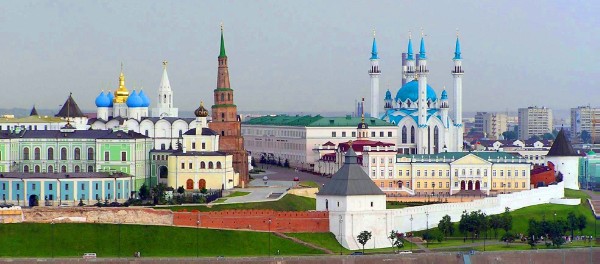Kazan - is the capital and largest city of the Republic of Tatarstan, Russia. One of the leading economic, political, scientific, educational, and cultural and sports centers in Russia. In the harmony of cultural, religious and linguistic diversity, the city is home for 1.2 million people - more than 100 nationalities.
The Kazan Kremlin is a World Heritage Site. In 2005, citizens celebrated the millennium of Kazan and in 2015, Kazan took fourth place in the ranking of the most popular tourist cities in Russia.

There are 44 institutes of higher education in Kazan, including 19 branches of universities from other cities. More than 140,000 students from 70 countries are educated in the city. Kazan Federal University (founded in 1804) is second oldest university in Russia after Moscow State University (1755). In 2009, KFU got Federal status. Now Kazan University has 19 institutes and faculties and 105 academic departments. It has over 47000 students, who follow 300 major degree programs.
The University is the center of science, science education, and culture and education. The first provincial newspaper and the book business in the region, theatrical life appeared in close connection with University.

The history of Kazan State University is associated with many world renowned figures, like the father of non-Euclidian geometry Nikolai Lobachevsky; the writer Leo Tolstoy; one of the discoverers of the Antarctic Ivan Simonov; the founder of organic chemistry Alexander Butlerov; a father of modern linguistics Jan Baudouin de Courtenay; the discoverer of electron spin resonance Evgeniy Zavoisky; and the Soviet leader Vladimir Ulianov-Lenin.



First geological research began at the University in the early 19th century. Adolph-Theodor Kupffer, Frederick F. Rosen, Peter I. Wagner and Georgy V. Wulf conducted the first research on mineralogy, petrography and crystallography.
The research of Carboniferous and Permian of Volga and Kama Region is tightly connected with the name of Roderick Murchison and his colleagues who undertook several expeditions in European Russia in 1840-1841.
The Kazan School of Geology was established in the 1860`s, headed by the first professor of geology Nikolai A. Golovkinsky, the founder of facies studies in Russia.
His follower Alexander A. Stukenberg, had been working in Kazan for 30 years and was rightfully considered as the founder of Kazan Geological School.
Alexander A. Stukenberg conducted the first geological survey of the Kazan province, vast areas of Urals, Volga, Pechora region and the basin of the Kama River. His disciples Peter I. Krotov, Michael E. Noinsky and Michael E. Yanishevsky continued to carry out geological, biostratigraphic and hydrogeologic study of the Volga-Kama basin and the western Urals.
University geologists made a huge contribution to the exploration and development of oil and gas fields of Russia and Tatarstan.
In 1949 established an independent faculty. In 2011, the Geological Faculty transformed into Institute of Geology and Petroleum Technology.

At the present time the institute has about a thousand students. Graduates of Institute are highly valued not only professional, but also human qualities. Spirit of Kazan Geological Faculty is strong, he is for all times.
The Stukenberg Museum of Geology and Mineralogy of Kazan State University is one of the oldest and richest natural science museums in Russia. Those ones were established at higher educational institutions in the end of the XVIII century and had both home and foreign collections unlike regional museums formed later on. The museum was founded in 1804 in accordance with the I Order of the Kazan Emperor University.
A two-century history of the museum development shows close interaction between scientists' creativity and results of their work as monographic collections have always been an integral part of scientific researches. For many generations of geologists the museum collections are that initial documents, which serves as a basis for researches and general conclusions as well as for definition of new scientific ideas. To save one's own "golden collection" and its history for future generations is a primary task of all natural science museums of Russia.
The contemporary store of the museum implies six main sections: ores, minerals and petrography; paleontology; dynamic geology and facies; monographic collections; geology of our region, mineral products of Tatarstan; scientific archive of museum history. There are more than 150000 samples from 60 countries in the museum, including collections of meteorites, rocks, minerals, ores, fossils of plants and animals.
Nowadays the KFU Museum of Geology and Mineralogy is one of the richest higher educational institution museums in the country. It is included in international and regional mineralogy reference books being a member of International Council of Museums (ICOM), the Commission by Mineralogy Museums of the Russian Academy of Sciences and Academic Council of the Tatarstan National Museum. It closely collaborates with regional and foreign natural science museums and geology institutions, providing collections' exchange and publications and realizing joint geological projects.